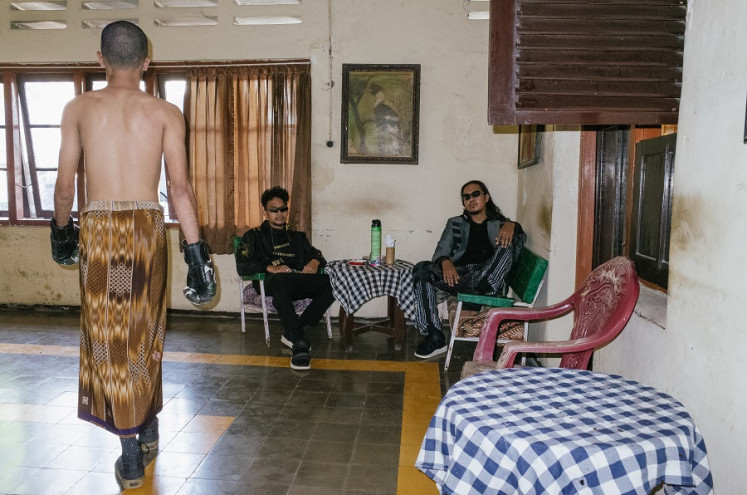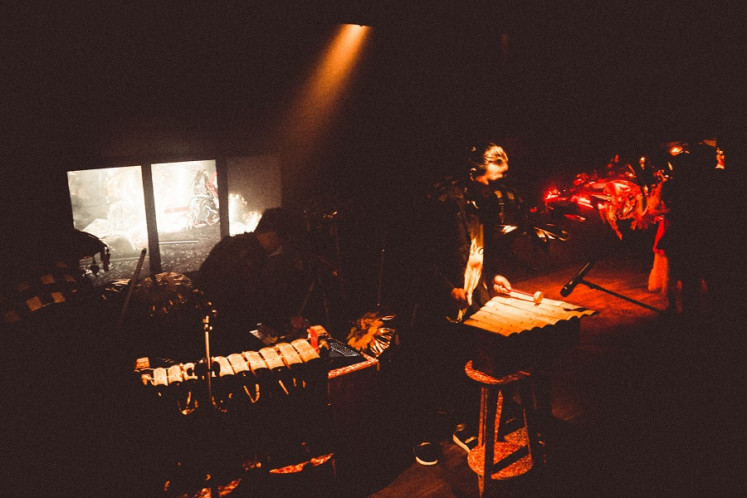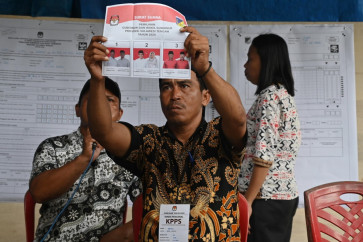Popular Reads
Top Results
Can't find what you're looking for?
View all search resultsPopular Reads
Top Results
Can't find what you're looking for?
View all search resultsKadapat is Bali’s best hidden musical treasure
Change text size
Gift Premium Articles
to Anyone
Uncompromising, sacrilegious, and intense – Kadapat is one of the best hidden talents in Bali’s promising music scene.
Finding Kadapat is a journey in itself. There is barely any footage of its intense live performances online. There are no traces of its music, not even a leaked demo or a teaser track on social media. In an age of hyper-visibility and bands releasing photo shoots before actual songs, Kadapat chooses to exist almost as a myth.
But for those who have watched Kadapat live, the hype is real: this is one of the most promising bands to come out of Bali in almost a decade.
“We have a different way of thinking about so-called tradition,” Gede Yogi Sukawiatnyana, one half of the duo, said. “We have no idea where we are going with this and who would want to listen. Maybe that’s why we’ve got along this far.”
With their art school background, their studious demeanor and their habit of bringing two different gamelan instruments on stage, you would be forgiven for thinking this was just another run-of-the-mill ethnic fusion balderdash group. But of course not. Kadapat's genre-defying compositions have taken it to clubs, underground raves and experimental shows alike, performing in front of rabid audiences that dance almost into a state of trance.
Its reimagining of traditional instruments has seen it push far into the left of Balinese gamelan music – mixing so-called profane instruments with supposedly holy ones, breaking boundaries and taboos along the way. Kadapat’s music is a distillation of the island’s complex musical story, and its inhabitants' desperate attempts to claw back its identity.
Youthful spirit: Instead of casting off their identity, Kadapat embraces being Balinese. _We just want to make music we've never heard of,_ they say (Courtesy of Kadapat) (Personal collection/Courtesy of Kadapat)Meeting the sacred and profane
It started, naturally, with the sense that things, as they were, weren’t enough. Yogi met I Gusti Nyoman Barga Sastrawadi while the pair were studying performing arts in Denpasar. The two quickly bonded over their love of electronic music and their mutual frustration with the state of Balinese arts.
“We felt Balinese gamelan tradition had settled into a comfort zone with all its smoke and mirrors,” Yogi said. “There are certain aesthetics, styles and unspoken rules kept in place by artists in power, and it’s almost impossible to challenge them.”
Fueling this conservatism was the force of tourism, which motivates Balinese masters to tone down and change their artistic expressions to better suit the palate of foreigners. “Costumes gradually became more important in musical performances because they looked good, epics like Calon Arang were shortened and changed,” Yogi said. “After years of this iteration, artists thought they had found a formula that tourists love and would make them money. They think it’s enough. Why mess around again?”
Kadapat was formed simply as a safe space for Yogi and Barga to experiment with their music far from the confines of tradition and academia. Initially a trio, they were forced to rethink when their vocalist dropped out just before a proposed debut performance. Instead of rejecting their traditions outright, though, they made the fateful decision to return to their roots.
Barga, a native of Karangasem, dug up a set of gender, a metal instrument which forms an integral part in a Balinese gamelan ensemble, from his family home. Meanwhile, Yogi scoured Denpasar and impulsively bought a set of jegog, an instrument that forms the gamelan ensemble characteristic of his native region, Jembrana.
Some context is necessary to understand why pairing a gender and a jegog in a gamelan ensemble is simply not something that happens anywhere in Bali. “The jegog was born from disgrace, and gender was born from the Gods,” said Yogi. “Their provenance, sound and materials say a lot about the people who made them and used them.”
“The gender emerged from the kingdoms of Bali,” Barga affirmed. A near-universal instrument in traditional Balinese gamelan ensembles, gender is made with metal and is beautifully adorned. Older gender were reportedly laced with gold, a sign of its value, its deep cultural significance and its maker’s highborn status. Gender is ubiquitous in ancient temples, sacred rituals and old-school performances of Balinese art.
Conversely, the jegog was made out of bamboo and was created by farmers, not priests or royal artisans. It was also born in a land of castaways. “The jegog hailed from Jembrana, a region that historically was a place for exiles from the Balinese kingdoms,” Yogi said. “People here lived by clearing forests and carving out a dominion for themselves. It was frontier country, and the jegog reflects that spirit.”
Sonically, the gender and jegog are also night and day. “The gender has a softer, more delicate sound. There will always be a sense of refinement to its, even if the composition calls for a bit of dynamism,” Yogi said. “Meanwhile, it’s hard to sound soft with jegog, because the material has a rough natural sound.”
When the two met up with their native instruments for the first time, their initial assignment was to get past the mental hurdle of working with two instruments laden with context. “Where I’m from, the gender is used in religious ceremonies and rituals,” Barga explained. “So there’s a strange sense when I took it out of its context and used it for art and entertainment. It’s difficult to imagine it in a different context.”
The pair worked hard to just “see their instruments as instruments, nothing else”, and stumbled upon a myriad of new, unexpected musical possibilities. “When the two instruments met, we didn’t expect the sounds that came out,” Yogi said.
Kadapat gradually built up a reputation as one of Bali’s fiercest live bands, often collaborating with visual artists, dancers and theater groups to create wild, multidisciplinary live performances. During a recent performance at the underground event Fraksi Epos, for example, they collaborated with musician Kuntari (whose album was dubbed The Jakarta Post’s best album of 2021), visual artist Adit Washere and pop-up restaurant FED by Made Danu in an installation depicting a dystopian future Bali.
Its stints taking over clubs, raves and exhibition spaces have surprised Barga and Yogi each time. “The jegog is appreciated in Jembrana, but every time the instrument goes anywhere else, at best it is presented as a performance to welcome foreign dignitaries and guests,” Yogi said. “When we bought the gender and jegog to clubs and saw people dancing to them, we felt weird. It all just seems so absurd!”
Trailbalzing: Kadapat, the Bali-based duo, fuses two gamelan instruments and chaotic electronic beats to a rabid dancefloor (Courtesy of Kadapat) (Personal collection/Courtesy of Kadapat)Regaining their future
Spreading through word of mouth, Kadapat’s intense live performances caught the attention of Aditya Surya Taruna (better known as Kasimyn), a producer and one-half of internationally acclaimed dance music duo Gabber Modus Operandi. After striking up a friendship with them at a gig, Kasimyn signed Kadapat to his label, Gorong-Gorong Records.
“Their music is the answer to a question I didn’t know I had,” Kasimyn said. “This was music that defied algorithms. There’s no way anyone else anywhere else in the world could make this music despite their access to information online. Kadapat couldn’t happen in Jakarta, Yogyakarta or Ambon. They could only be born in Bali.”
Kadapat's debut album – which is still untitled at the time of writing – is expected to be released within a month. Just as unhinged and overwhelming as their live performances, the album is a mishmash of musical influences. Notes of African polyrhythm, IDM-style breakdowns and even intense gabber beats make for an album that sounds like the soundtrack to a bastardized ritual. Meanwhile, forget the dulcet tones of traditional gamelan – on certain tracks, it is used sparingly, on others it is treated almost as percussion.
Central to the album is the legend of Nyi Blorong, a legendary figure in Indonesian mythology often depicted as half-woman, half-snake. Described as the queen of pesugihan (a series of rituals to gain riches in exchange for offerings) Nyi Blorong is Indonesia’s answer to the Faustian bargain.
“When we read more about pesugihan, we found that you actually exchanged all the karma from good deeds you’ve done in exchange for riches,” Yogi said. “So when you die, you have no good left.”
They found parallels of this in Bali’s complex relationship with tourism. “It’s a big moneymaker at first, but you start to see how it has affected us during this pandemic,” Yogi continued. “Even our art felt like a blood sacrifice. We gutted our own art to make it pretty so foreigners could take a look at it. But now that they’re gone, what do we have left?”
According to Yogi, Kadapat’s music tries to present a journey of regaining one’s culture, of affirming one’s identity regardless of external approval. “Their music departs from anger and was triggered by desperation,” Kasimyn observed. “It’s as if they’re saying: ‘Look, this is what we’re going to make. If you accept it, that’s good, if you don’t, then that’s fine.’ They’re at peace with who they are as Balinese people. This is who we are, take it or leave it.”
That sense of challenge and unflinching commitment to experimentation made them who they are. “We want to break free from conventions, confound people and make them dance,” Yogi concluded. “In essence, we just want to make something we’ve never heard before.”












